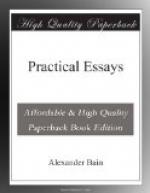In 1857, a near approach was made to open competition, in the case of four clerkships awarded by the competing examination in the Commissioners’ own establishment. “The fact of the competition was not made public, but was communicated to one or two heads of schools and colleges, and mentioned casually to other persons at various times. The number of competitors who presented themselves was forty-six, of which number, forty-four were actually examined.”
[BEGINNING OF OPEN COMPETITION.]
It was reserved for 1858 to see the first absolutely open competition, in the case of eight writerships in the Office of the Secretary of State for India; and in that year, too, a step in advance was made when the Commissioners in their Report “pointed out the advantage which would result from enlarging the field of competition by substituting, for the plan of nominating three persons only to compete for each vacant situation, the system of nominating a proportionate number of candidates to compete for several appointments at one examination”.
The year 1860 sounded the death-knell of simple pass examination. It was then recommended by a Select Committee of the House of Commons, and the recommendation was adopted, that the competitive method, in its limited form, should be henceforth universally applied to junior situations. This recommendation was at once acted upon in the case of clerkships under the control of the Lords Commissioners of the Treasury, and others by and by followed; but, as matter of fact, it was never strictly carried out in all its scope and rigour; and as late as 1868 the Commissioners in their Report stated that “the number of situations filled on the competitive method has been comparatively small”. Meanwhile, competitive examination was making way in other quarters.
From 1857, the Commissioners had been in the habit of examining competitively, at the request of the Lord Lieutenant of Ireland, such candidates as might be nominated for cadetships in the Royal Irish Constabulary; and, in 1861, the Lords Commissioners of the Admiralty “threw open to public competition” appointments as apprentices in Her Majesty’s dockyards, and appointments as “engineer students” in the steam factories connected therewith.
In 1870, the end so long aimed at was attained, and by an Order in Council of June 4, open competition was made the only door of entry to the general Civil Service.
In entire contrast with this, as has been already said, was the action in the case of the Indian Civil Service. Here the principle of open competition was adopted from the first, and the examination took a very elevated start, comprising the highest branches of a learned education. These branches were duly specified in a Report drawn up in November, 1854, by a Committee, of which Lord Macaulay was chairman; and, with the exception of Sanskrit and Arabic, they included simply (as might have been expected) the literary and scientific subjects ordinarily taught at the principal seats of general education in the Kingdom. These were:—




